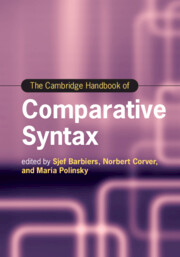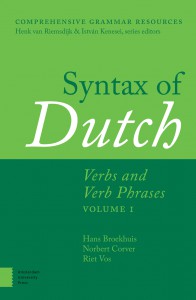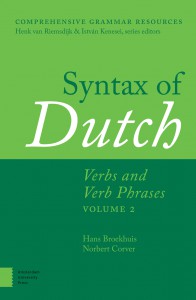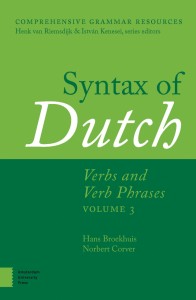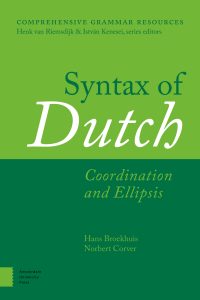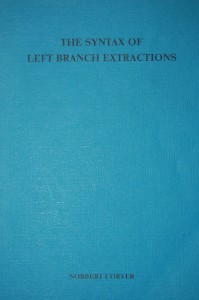Sjef Barbiers, Norbert Corver & Maria Polinsky (eds.), The Cambridge Handbook of Comparative Syntax. Cambridge: Cambridge University Press. (to appear in 2025)
Bringing together a globally representative team of scholars, this Handbook provides a comprehensive overview of comparative syntax, the study of universal and variable properties of the structure of building blocks in natural language. Divided into four thematic parts, it covers the various theoretical and methodological approaches to syntactic variation; explores dependency relations and dependency marking; shows how the building blocks of syntax both vary and display universal properties across languages, and explores the interfaces between syntax and other aspects of language structure. It also includes examples from a typologically broad range of languages, as well as data from child language, sign language, language processing, and diachronic syntax, giving a clear picture of the ubiquity of cross-linguistic variation. It serves as a source of inspiration for future research, and forges a deeper understanding of the variant and invariant parts of language, making it essential reading for researchers and students in linguistics.
Contributors: Sjef Barbiers, Norbert Corver, Maria Polinsky, Guido Vanden Wyngaerd, Jenneke van der Wal, Balthasar Bickel, Jessica K. Ivani, Jeroen van Craenenbroeck, Marjo van Koppen, Tim Hunter, Robert Frank, Polina Pleshak, Adam Ledgeway, Maria Teresa Guasti, Elena Pagliarini, Paula Fenger, Maria Kouneli, Elizabeth Ritter, Martina Wiltschko, Artemis Alexiadou, Marcel den Dikken, Éva Dékány, Hamida Demirdache, Hongyuan Sun, Jim Wood, Matthew Tyler, Jan-Wouter Zwart, Raffaella Zanuttini, Paul Portner, Miok Pak, Emily Clem, Mark Norris, Ian Roberts, Suzanna Fong, Claire Halpert, Martin Everaert, Eric Reuland, Peter Jenks, Lisa Lai-Shen Cheng, Radek Simik, Klaus Abels, Veneeta Dayal, David Embick, Ad Neeleman, Roland Pfau, Josep Quer, Fatima Hamlaoui, Kriszta Szendroi, Brian Dillon, Maayan Keshev
Hans Broekhuis & Norbert Corver. (i) Verbs and Verb Phrases, Volumes I (with Riet Vos), II and III, (ii) Coordination and Ellipsis . Amsterdam University Press.
The Syntax of Dutch series synthesizes the currently available syntactic knowledge of Dutch.
‘Syntax of Dutch: Verbs and Verb Phrases’ consists of three volumes. Volume 1 opens with a general introduction to verbs, including a review of various verb classifications and discussions on inflection, tense, mood, modality and aspect. This is followed by a comprehensive discussion of complementation (argument structure and verb frame alternations). Volume 2 continues the discussion of complementation, but is more specifically focused on clausal complements: the reader will find detailed discussions of finite and infinitival argument clauses, complex verb constructions and verb clustering. Volume 3 concludes with a description of adverbial modification and the overall structure of clauses in relation to, e.g., word order (verb placement, wh-movement. extraposition phenomena, scrambling, etc.).
The volume ‘Coordination and Ellipsis’ addresses issues relating to coordination. It contains three chapters. Chapter 1 discusses the syntactic and semantic properties of coordinate structures and their constituting elements, that is, the coordinators and the coordinands they link. Chapter 2 discusses the types of ellipsis known as conjunction reduction and gapping found in coordinate structures. Chapter 3 discusses elements seemingly exhibiting coordination-like properties, such as dan ‘than’ in comparative constructions like Jan is groter dan zij ‘Jan is taller than she’.
[Link to Volume 1] [Link to Volume 2] [Link to Volume 3] [Link to Volume 4]
LISA LAI-SHEN CHENG & NORBERT CORVER (eds.). DIAGNOSING SYNTAX. (2013). Oxford University Press.
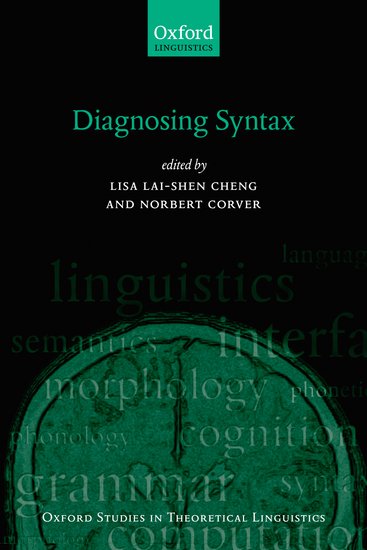
Diagnosis is an essential part of scientific research. It refers to the process of identifying a phenomenon, property, or condition on the basis of certain signs and by the use of various diagnostic procedures. This book is the first ever to consider the use of diagnostics in syntactic research and focuses on the five core domains of natural language syntax – ellipsis, agreement, anaphora, phrasal movement, and head movement. Each empirical domain is considered in turn from the perspectives of syntax, syntax at the interfaces, neuropsycholinguistics, and language diversity. Drawing on the expertise of 20 leading scholars and their empirically rich data, the book presents current thoughts on, and practical answers to, the question What are the diagnostic signs, techniques and procedures that can be used to analyse natural language syntax? It will interest linguists, including formalists, typologists, psycholinguists and neurolinguists.
Contributors: Elena Anagnostopoulou, Sergey Avrutin, Sergio Baauw, Lisa Lai-Shen Cheng, Sandra Chung, Norbert Corver, Jeroen van Craenenbroeck, Hamida Demirdache, Martin Everaert, Lyn Frazier, Naama Friedmann, Maria Teresa Guasti, Heidi Harley, Winfried Lechner, Anikó Lipták, Ora Matushansky, Jason Merchant, Jamal Ouhalla, David Pesetsky, Christer Platzack, Maria Polinsky, Eric Potsdam, Norvin Richards, Christopher Tancredi, Susanne Winkler, Jochen Zeller.
Lisa Lai-Shen Cheng & Norbert Corver (eds.). (2007) Wh-Movement: Moving On. Cambridge, Mass.: The MIT Press. (foreword by Noam Chomsky)
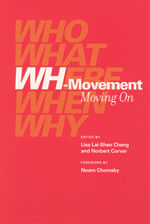 Wh-movement—the phenomenon by which interrogative words appear at the beginning of interrogative sentences—is one of the central displacement operations of human language. Noam Chomsky’s 1977 paper “On Wh-Movement,” a landmark in the study of wh-movement (and movement in general), showed that this computational operation is the basis of a variety of syntactic constructions that had previously been described in terms of construction-specific rules. Taking Chomsky’s paper as a starting point, the contributors to this collection reconsider a number of the issues raised in “On Wh-Movement” from the perspective of contemporary Minimalist syntactic theory (which explores the thesis that human language is a system optimally designed to meet certain interface conditions imposed by other cognitive systems with which the language faculty interacts). They discuss such wh-movement issues as wh-phrases and pied-piping, the formation of A-bar chains and the copy theory of movement, cyclicity and locality of wh-movement, and the typology of wh-constructions. By reconsidering core characteristics of the wh-movement operation first systematically discussed by Chomsky from the Minimalist perspective, this volume contributes to the further development of the theory of wh-movement and to the general theory of movement.
Wh-movement—the phenomenon by which interrogative words appear at the beginning of interrogative sentences—is one of the central displacement operations of human language. Noam Chomsky’s 1977 paper “On Wh-Movement,” a landmark in the study of wh-movement (and movement in general), showed that this computational operation is the basis of a variety of syntactic constructions that had previously been described in terms of construction-specific rules. Taking Chomsky’s paper as a starting point, the contributors to this collection reconsider a number of the issues raised in “On Wh-Movement” from the perspective of contemporary Minimalist syntactic theory (which explores the thesis that human language is a system optimally designed to meet certain interface conditions imposed by other cognitive systems with which the language faculty interacts). They discuss such wh-movement issues as wh-phrases and pied-piping, the formation of A-bar chains and the copy theory of movement, cyclicity and locality of wh-movement, and the typology of wh-constructions. By reconsidering core characteristics of the wh-movement operation first systematically discussed by Chomsky from the Minimalist perspective, this volume contributes to the further development of the theory of wh-movement and to the general theory of movement.
Contributors: Brian Agbayani, Lisa Lai-Shen Cheng, Sandra Chung, Norbert Corver, Caterina Donati, Kleanthes K. Grohmann, Toru Ishii, Heejeong Ko, Howard Lasnik, Philip LeSourd, Chris H. Reintges, Luigi Rizzi, Balázs Surányi, Akira Watanabe, Henrietta Yang
Norbert Corver & Jairo Nunes (2007). The Copy Theory of Movement. Amsterdam/Philadelphia: John Benjamins.
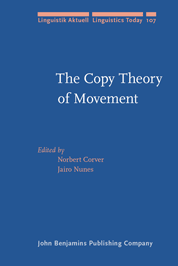 This volume brings together papers which address issues regarding the copy theory of movement. According to this theory, a trace is a copy of the moved element that is deleted in the phonological component but is available for interpretation at L(ogical) F(orm). Thus far, the bulk of the research on the copy theory has mainly focused on interpretation issues at LF. The consequences of the copy theory for syntactic computation per se and for the syntax–phonology mapping, in particular, have received much less attention in the literature, despite its crucial relevance for the whole architecture of the model. As a contribution to fill this gap, this volume congregates recent work that deals with empirical and conceptual consequences of the copy theory of movement for the inner working of syntactic computations within the Minimalist Program, with special emphasis on the syntax–phonology mapping.
This volume brings together papers which address issues regarding the copy theory of movement. According to this theory, a trace is a copy of the moved element that is deleted in the phonological component but is available for interpretation at L(ogical) F(orm). Thus far, the bulk of the research on the copy theory has mainly focused on interpretation issues at LF. The consequences of the copy theory for syntactic computation per se and for the syntax–phonology mapping, in particular, have received much less attention in the literature, despite its crucial relevance for the whole architecture of the model. As a contribution to fill this gap, this volume congregates recent work that deals with empirical and conceptual consequences of the copy theory of movement for the inner working of syntactic computations within the Minimalist Program, with special emphasis on the syntax–phonology mapping.
Contributors: Željko Boškovic, Lisa Lai-Shen Cheng, Norbert Corver, Tomohiro Fujii, Norbert Hornstein, Jason Kandybowicz, Marjo van Koppen, Ana Maria Martins, Jairo Nunes, Chris H. Reintges, Sandra Stjepanovic.
Hans Broekhuis, Norbert Corver, Riny Huybregts, Ursula Kleinhenz, Jan Koster (eds.). (2005) Organizing Grammar. Studies in Honor of Henk van Riemsdijk. Berlin/New York: Mouton de Gruyter.
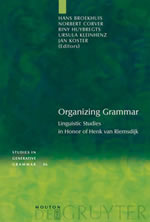 Henk van Riemsdijk has long been known as one of Europe’s most important linguists. His seminal ideas have been influential in developing generative grammar in Europe and beyond. As the initiator, co-founder, and chair of the GLOW society, he made the society the leading platform of European generative linguistics. He has also been editor of the series Studies in Generative Grammar since its foundation. As a teacher and supervisor, he has inspired generations of students. On the occasion of his relocation from the Netherlands to Italy, his friends, students and colleagues celebrate his work with this collection of essays on numerous topics of current theoretical interest.
Henk van Riemsdijk has long been known as one of Europe’s most important linguists. His seminal ideas have been influential in developing generative grammar in Europe and beyond. As the initiator, co-founder, and chair of the GLOW society, he made the society the leading platform of European generative linguistics. He has also been editor of the series Studies in Generative Grammar since its foundation. As a teacher and supervisor, he has inspired generations of students. On the occasion of his relocation from the Netherlands to Italy, his friends, students and colleagues celebrate his work with this collection of essays on numerous topics of current theoretical interest.
Norbert Corver & Henk van Riemsdijk (eds.). (2001) Semi-lexical Categories. The Function of Content Words and the Content of Function Words. Berlin/New York: Mouton de Gruyter.
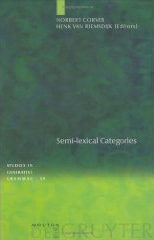 The distinction between functional categories and lexical categories is at the heart of present-day grammatical theory, in theories on language acquisition, code-switching and aphasia. At the same time, it has become clear, however, that there are many lexical items for which it is less easy to decide whether they side with the lexical categories or the functional ones. This book deals with the grammatical behavior of such in- between-categories, which are referred to here as “semi-lexical categories”.
The distinction between functional categories and lexical categories is at the heart of present-day grammatical theory, in theories on language acquisition, code-switching and aphasia. At the same time, it has become clear, however, that there are many lexical items for which it is less easy to decide whether they side with the lexical categories or the functional ones. This book deals with the grammatical behavior of such in- between-categories, which are referred to here as “semi-lexical categories”.
Contributors: Tanmoy Bhattacharya, Miriam Butt, Anna Cardinaletti, Norbert Corver, Kristin M. Eide, Joseph Emonds, Wilhelm Geuder, Giuliana Giusti, Tjerk Hagemeijer, Hubert Haider, Elisabeth Löbel, Susan M. Powers, Joan Rafel, Henk van Riemsdijk, Carson Schütze, Ludmila Veselovská, Jochen Zeller, Tor A. Åfarli.
Norbert Corver & Henk van Riemsdijk (eds.). (1994) Studies on Scrambling. Movement and Non-Movement Approaches to Free Word Order Phenomena. Berlin/New York: Mouton de Gruyter.
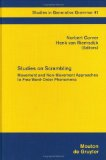 This volume deals with the issue of “scrambling”, i.e. the phenomenon of variable word order within a clause. It presents a variety of approaches towards scrambling, more specifically: (i) a base generation approach (with a further distinction between configurational and non-configurational approaches), (ii) a movement approach (with a further distinction between an A-movement approach, an A-bar movement one, and a mixed A-+A-bar- movement approach. The scrambling data discussed in this volume come from a variety of languages, including Danish, Dutch, Finnish, German, Hindi, Hungarian, Japanese, Korean, Persian, Seleyarese, and Warlpiri.
This volume deals with the issue of “scrambling”, i.e. the phenomenon of variable word order within a clause. It presents a variety of approaches towards scrambling, more specifically: (i) a base generation approach (with a further distinction between configurational and non-configurational approaches), (ii) a movement approach (with a further distinction between an A-movement approach, an A-bar movement one, and a mixed A-+A-bar- movement approach. The scrambling data discussed in this volume come from a variety of languages, including Danish, Dutch, Finnish, German, Hindi, Hungarian, Japanese, Korean, Persian, Seleyarese, and Warlpiri.
Contributors: Marguerite Browning, Norbert Corver, Viviane Deprez, Daniel L. Finer, Kenneth Hale, Ezat Karimi, Katalin É. Kiss, Jaklin Kornfilt, Young-Suk Lee, Anoop Mahajan, Gereon Müller, Ad Neeleman, Urpo Nikanne, Henk van Riemsdijk, Beatrice Santorini, Wolfgang Sternefeld, Ayumi Ueyama, Sten Vikner.
Norbert Corver (1990). The Syntax of Left Branch Extractions. PhD dissertation, Tilburg University.
Chapter 1: Introduction; Chapter 2: Historical background of the left branch extraction problem; Chapter 3: The internal syntax of phrases; Chapter 4: Against wh-movement in Dutch and English subcomparatives; Chapter 5: Split and non-split ‘wat’-exclamative constructions in Dutch; Chapter 6: ‘Wat voor’-split in Dutch; Chapter 7: Determiner, degree word and possessor extraction; Chapter 8: Left branch extraction from AP and DegP; Chapter 9: Left branch extraction from PP; Chapter 10: Left branch extraction from noun phrases.





